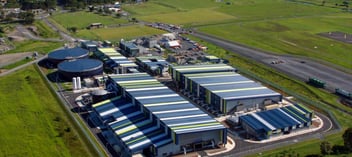Seqwater strategy boosts supply resilience
Severe weather events are becoming both more common and more disruptive — with notable impact on water management. They highlight the limitations of routine practices and the potential efficacy of new or previously under-used approaches when it comes to managing such events, mitigating their impact and building resilience.
A “catchment to tap” approach to water management has significantly bolstered supply resilience in the rural south-east Queensland town of Beaudesert. Toyah Foote, Seqwater Senior Drinking Water Quality Adviser, will discuss the key role stakeholder engagement and collaboration has played in this process at Ozwater'21.
Foote explains that the Beaudesert Water Treatment Plant (WTP), which extracts raw water from an unprotected catchment centred on the Logan River system, is subject to “shock loads” of ammonia, amid a high potential impact from upstream agriculture and industry, affecting the WTP disinfection process.
This risk is exacerbated by heavy rainfall, with the WTP typically shut down for one or two days during an event while allowing it to pass. However, an extreme rainfall event in 2016 resulted in an extended shutdown, bringing supply resilience issues into sharp focus.
“When starting the treatment plant up again, high levels of ammonia were detected, which we couldn't treat,” says Foote.
“The plant had to stay offline, which caused a near loss of supply. We had to organise tankering to top up the service water reservoirs in the system, which is not a long-term option.
“That led to us looking at what we could do at the plant, and also how to mitigate the issue, or to prevent it from occurring.”
A two-pronged approach
Foote describes Seqwater's approach as broadly being “two-pronged”: the bulk water supply authority acts as operations lead in undertaking widespread engagement with industry throughout the catchment, while also implementing upgrades that would allow the WTP to treat ammonia events and reduce potential loss-of-supply risks.
A particular focus of her Ozwater'21 presentation will be the opportunity the water industry has to engage with catchment industries directly, and the tangible benefits that can be achieved by creating an open and ongoing dialogue with stakeholders.
“We worked with these industries so that they could understand our issues and we could understand theirs,” Foote explains.
“We had our regional operations manager lead the charge in terms of door-knocking industries in the catchment to try and get some engagement.”
This peer-to-peer approach involved developing an understanding of the respective operations of different stakeholders and opening more collaborative lines of communication, underpinning a shared interest among all stakeholders in maintaining catchment health.
“The engagement was so positive and effective that we ended up reducing ammonia events in the catchment to the point where they're no longer an issue for us.”
As a result, Foote says Seqwater has not had to use a breakpoint chlorination and granulated activated carbon filtration system, which augments the WTP's treatment capabilities in the case of an event, as it was originally designed.
Instead, Seqwater has been looking to put the system to use across other areas, including managing disinfection by-products.
“Although we haven't had to use it as it was designed, it turns out to be of huge benefit in terms of managing a baseline water quality risk,” Foote said.
“We'll continue to look at operating it and maintaining it for that reason.”
Working together
With climate change heightening the potential for extreme weather events, Foote points to the importance of understanding the risks posed to treatment plants during events, and of being prepared to deal with those risks.
“It's really difficult to identify the source at a particular site that leads to these issues; however, we know that it's activities in the catchment that are the cause,” she said.
“It's important to undertake event monitoring, and to know how your source water is changing during those events, which perhaps fits outside the routine monitoring undertaken at treatment plants.”
Foote describes her Ozwater'21 presentation as ultimately being a positive case study of how different industries, each with important roles to play in the local community, can work together to achieve broadly beneficial outcomes.
“While 2016 was the tipping point, it allowed us to really kick off those working relationships with other catchment industries, which has proven extremely effective in reducing instances of supply impact,” she says.
“It's really a good news story about how water utilities and managers can influence water quality with engagement with other industries in the catchments. In this instance, we had a really measurable improvement in the raw water ammonia levels.”
To learn more about the unique approach implemented by Seqwater at Beaudesert Water Treatment Plant, don’t miss Toyah Foote’s presentation at Ozwater’21 on Tuesday 4 May. Click here to register.

